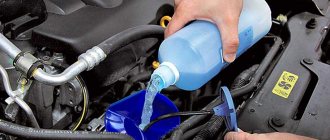Pros and cons of heated garages
In addition to the fact that a heated garage is warm, there are also the following advantages:
- the engine oil does not thicken in the engine, which makes it easier to start;
- Thanks to easy engine starting, car parts wear out less, which increases the service life of the car;
- after washing, the locks on the doors will not freeze;
- It is more pleasant to carry out car repairs in a warm room.
Of course, there are also disadvantages here, such as:
- fuel or electricity costs;
- it will take additional time to install the system and then maintain it;
- Any heating device is an object of increased danger and must be monitored.
There are many more advantages, but you still shouldn’t neglect your own safety.
Advantages and disadvantages of various systems
Every motorist wants heating to be as cheap as possible, but at the same time to be efficient and safe. The easiest way is if the garage is located near the house, then it will actually be easy to install a radiator and connect it to the general heating system.
However, such favorable conditions rarely happen, so let’s look at how to heat a garage in winter so that it is economical. The instructions describe the entire process in detail, and after looking at the photos and videos, each owner will be able to decide for himself which method is best for him. Let's consider several methods.
Electric way
The most common way to heat a garage is electric, but this raises the question of which type of radiator to choose. Infrared heaters are not cheap, but they consume little electricity. Heat guns are good because they heat the room in a matter of minutes, but their downside is that electricity bills will increase greatly; convectors are in the middle.
It is necessary to take into account that when choosing a heat gun, be prepared for the fact that it will raise the smallest particles of dust into the air, and you will have to breathe through it
Infrared heater
Infrared heaters in various designs: tripod, wall and ceiling
The operation of the device is based on the emission of infrared rays, which, reaching the surface of objects along the path of propagation, heat them, and they, in turn, give off heat to the room. Such devices are sometimes called UFO heaters, but UFO, the common Cyrillic abbreviation of the same name in everyday life, has nothing to do with ultraviolet irradiation.
UFO heaters are available in various sizes and power; they can be on a leg or designed to be attached to a vertical or horizontal base (wall, ceiling). Provided the housing is waterproof or placed under a canopy, infrared heaters can also be used in front of the garage on the street.
Pros of IR heaters:
- economical electricity consumption;
- ease of operation and installation;
- reliability, safety and environmental friendliness.
The disadvantage of infrared heaters when used in a confined garage space is the effect of infrared rays on a small area, which causes less heat transfer from objects into the air. But when focusing radiation in the direction of the actual zone, these heaters are quite effective.
Important! The significant heating of the housing of UFO heaters during operation requires caution when handling the device in a cramped garage.
Solid fuel stoves
If the question arises of how to heat a garage economically in winter, then installing a stove would be a fairly profitable option. The cost of coal and firewood is low, and you can also burn anything unnecessary in the stove, this could be various scraps or cardboard. Based on the instructions, photos and videos, it’s possible to make a stove yourself in the garage. The advantages of this method are that you do not need to obtain permits and there is no need to connect to central heating systems.
The disadvantages include the possibility of fire, so vigilant monitoring of the combustion process is necessary to prevent the release of carbon monoxide.
A potbelly stove would be an ideal option, but when installing it, you should not neglect safety rules. It is necessary to place a sheet of asbestos or metal under the stove, and make sure that there are no flammable substances in the room.
Heating with gas
This is the cheapest heating method, however, in order to connect to the mains you will have to collect a lot of pieces of paper. And unauthorized connection threatens the car owner with an impressive fine.
Therefore, for a garage it is better to use cylinder heating, and you need to choose a device that uses fuel most economically.
When choosing a gas heater, you need to consider the following nuances:
- you will need an insulated cabinet where the cylinder will be stored;
- the closet will take up a lot of space;
- From time to time you will have to inspect the equipment to avoid gas leaks.
But despite all the negative aspects, such heating is quite reliable and economical.
Water heating
When deciding how to heat a garage economically in winter, you can consider installing a separate water boiler. You can actually make such a unit yourself if you use the instructions and look at photos and videos on the Internet. When equipping the system, it is better to use antifreeze as a coolant; this will eliminate possible defrosting of the pipes.
The whole system is based on the fact that the coolant is heated in the boiler and flows through pipes to the radiators. It can be of two types:
- Single-pipe - antifreeze passes sequentially through the pipe to the radiators. In this case, it is natural that the first battery will be significantly hotter than the last. With this system, there is a saving on the set of materials, but it is more suitable for small spaces.
- Two-pipe - heated antifreeze goes directly to each battery and, thanks to the return circuit, returns back to the boiler. This will require more effort and material investment, but if the garage is huge, then this is simply necessary.
The two-pipe system is more suitable for auto repair shops and service stations.
You can assemble a boiler for your garage yourself using an old radiator; the expansion tank is made from a plastic container. This will allow you to heat the garage with minimal material costs.
Water heating system
You need to understand that installing water heating makes sense when you are in the garage all the time. Otherwise, the costs will not justify themselves, because in addition to a source of heat and fuel, you will need to buy:
- cast iron or steel batteries (as an option, weld registers from pipes);
- circulation pump;
- expansion tank;
- pipes on the main line;
- non-freezing coolant - antifreeze.
For reference. The garage space is heated periodically, so the system cannot be filled with plain water.
Knowing the need for the amount of heat to heat the room (calculated in the previous section), select the power of the radiators or determine the length of the pipes of the homemade register using the table:
In the table, t1 means the coolant temperature, t2 means the air in the room
The calculation method is as follows. We take a steel pipe DN 80 (Ø89 mm) and find out from the table that 1 m of length is enough to heat an area of 1.37 m². We take the square footage of the garage, for example, 20 m² and divide by this figure: 20 / 1.37 = 14.6 m - the total length of the heating part. We distribute it among 2-3 heating devices and cook the registers according to the drawing.
Use the circulation pump with the lowest pressure (4 m of water column), and the expansion tank with the minimum volume. Pipes - polypropylene, steel or metal-plastic size DN 15. Then install radiators on 2 opposite walls and assemble a simple two-pipe closed-type heating system connected to a heat source according to the following diagram:
Instead of a wood-burning stove with a water circuit, an electric boiler or other heat source is installed in the circuit
The following can be used as a water heating installation:
- a wood-burning or exhaust stove with a water circuit, shown in the diagram above;
- heat exchanger – samovar-type economizer installed on the chimney;
- an electric heating element mounted in a vertical steel pipe, as shown in the diagram;
- a full-fledged electric boiler or solid fuel unit.
The simplest electric boiler with a water register
Advice. Do not forget to add a filter to the circuit - a mud trap and ball valves to cut off the heat source and drain water from the system. At the top point, install an automatic air vent, and on the batteries - Mayevsky valves for bleeding air.
Why don’t we recommend making an open-type system in the garage, as it is simpler and cheaper? The reason is antifreeze, which will evaporate from an open tank, which is unsafe for health (ethylene glycol is poisonous), not to mention the price of the coolant.
Liquid fuel boilers
Quite often, wondering how to heat a garage economically in winter, car owners opt for devices that run on diesel fuel, diesel fuel or waste fuel. If funds allow, then you can buy a ready-made device, although, having the instructions at hand, as well as looking at photos and videos, it is easy to assemble it yourself.
The body is usually made from a gas cylinder, old barrels or heat-resistant steel sheets. However, homemade stoves consume a little more fuel than industrial ones. For example, a heat gun consumes 0.5-0.7 liters of diesel fuel per hour, depending on the power.
Compact diesel stoves are very popular; they are also called a potbelly stove with a fan. There are two types of such heaters:
- Direct heating - this device does not have a chimney, so it is not suitable for a garage.
- Indirect heating - such devices are especially popular among garage owners. Its action is based on the following: through the fuel tank nozzle, diesel fuel passes into the chamber where it burns, thanks to the air supplied by the fan. After passing through the heat exchanger, hot streams enter the garage through the nozzle, quickly heating it.
The set of such a heater includes:
- fuel tank with a valve that can be easily removed;
- adjustment screw;
- replaceable block with wick;
- frame;
- lattice;
- burner;
- reflector.
Economical heating, fuel options
If you decide to make your garage heated, it is worth considering various solutions.
Elimination of heat loss
The first step to help get rid of the cold is to eliminate excessive drafts. It is advisable to use acrylic silicone or polystyrene foam for window frames, because the window is the source of valuable heat loss.
Owners of a metal garage have a little more concern, where the connections of structural elements are rarely precise. A sealed garage is not an absolute blessing. The point is the moisture present here in abundance. Lack of ventilation contributes to dampness and corrosion of the car’s sheet metal. It is necessary to maintain minimal ventilation by temporarily opening a window or door.
Electric garage heating
A common choice is portable heating. A popular inexpensive heating device is electric heaters. Electric heaters consist of a heater and an axial fan, which is responsible for the rapid distribution of heat in the room. Heaters for garage use typically have a metal body with a plastic handle for easy transportation. Small size and weight are the main advantages of electric heaters. When choosing a heater, you should find out whether it has adjustable power and a thermostat.
Heaters for technical premises around the house are distinguished by increased thermal power compared to their domestic counterparts. Small heaters convert 3-5 kW of electricity into heat, allowing you to effectively heat rooms of 20-25 square meters. Basic models of modern heaters can be purchased at an attractive price. Due to the high electrical current consumption, such heating is quite expensive.
How to reduce heat loss
Any garage heating system will be unprofitable if it blows from the cracks, so you need to take care of its insulation. The following materials are used for this:
- expanded clay;
- mineral wool;
- glass wool;
- polyurethane foam;
- penoizol.
But the most profitable is polystyrene foam, it has a low price, the level of insulation is not inferior to mineral wool, but at the same time it does not allow moisture to pass through. In addition, it is not susceptible to rotting and various fungi cannot grow on it.
They even insulate the floor with polystyrene foam, but only fill it with cement mortar for strengthening. The garage can be insulated both outside and inside, this is at the discretion of the car owner.
Why do you need heating in the garage?
In the summer, spring and autumn seasons, the garage space does not particularly need additional heating, but with the advent of cold weather and frost, its need becomes obvious. The fact is that as a result of temperature changes, as well as snow sticking to the bottom of the car, condensation can form in the garage. This phenomenon is extremely dangerous for cars, tools and other steel objects stored indoors. It provokes the appearance of corrosive processes in the metal. That is why a heated garage is the key to the longevity of the car and other useful items that live in it.
Before deciding how to heat the garage in winter, it is advisable to fulfill two more basic conditions to make the arrangement of the garage space as comfortable and correct as possible:
- Correctly executed ventilation in the garage, which will be responsible for the exit of moisture and exhaust gases from the room, as well as the entry of clean air.
- Insulation of the garage, which will allow you to retain more heat and reduce its loss.
Types of heating for the garage
The location of the building itself will help you decide how to heat your garage in winter. If the garage is part of the main house or is located a short distance from it, then general heating can be used. If the garage space stands alone or is too far from the house, then you will have to install an autonomous heating system in it.
Water heating
This system has been familiar to everyone since childhood. It is used in many residential buildings and premises. Its principle is based on the fact that water heated by a convector or boiler flows through a pipe system into radiators made of special alloys with high thermal conductivity. Due to their increased properties of releasing heat, radiators disperse it around themselves, thereby heating the room.
Water heating is appropriate only in cases where the garage is adjacent to the house or is large and is used for commercial purposes. If you equip a separate system for the garage, then its costs will be too high. In addition, for water heating of a garage, it is not ordinary water that is suitable, but antifreeze (which will not freeze in cold weather), the cost of which is several times higher.
To install water heating you will need the following devices and materials:
- Pipes (metal-plastic or PVC);
- Radiators;
- The heating device (boiler) is electric, fuel or gas.
Gas heating
It is believed that heating a garage with gas in winter is quite inexpensive due to the cheapness of the fuel itself. However, to install such heating you will need additional equipment, which is sometimes very expensive.
Today there are three gas garage heating systems:
- Using a gas boiler as a water heater for a water heating system;
- Application of gas in a heat gun;
- Equipping the garage with an infrared or catalytic gas heater.
As for a gas boiler, such a system would be appropriate only if the garage is located next to a heated house or it is planned to heat large rooms. Another basic condition for gas heating equipment is the presence of a nearby gas pipeline.
If the garage is separate from the house, then to install gas heating you will need:
- Preparation of documents for permitting gas heating;
- Heating system design;
- Heating system installation;
- Purchase and installation of a gas boiler.
This procedure will require large expenses, since the installation of the system and boiler must be carried out by professionals. It’s better not to joke with gas, because errors in installation or design can lead to disastrous consequences.
A heat gun or gas generator can be installed using a gas pipeline system, or you can equip it yourself using a liquefied gas cylinder. The operating principle of such a system is based on burning gas with a burner located in a gun and delivering the resulting energy to a special fan. When heat enters the fan, it sprays it around itself. The only drawback of such a system is the release of harmful combustion products into the air of the garage, so its installation requires a proper and powerful ventilation system.
The third type of gas heating involves the use of infrared or catalytic gas heaters. We got this type of heating relatively recently, but it has already attracted the interest of many garage owners.
As for catalytic heaters, they are considered safer than infrared heaters, since during the combustion of gas, almost 95% of its harmful substances are eliminated by the device itself. Infrared heaters release air into the room along with combustion products.
If you ask yourself whether it is better to heat a garage with electricity or gas when using an infrared heater, then the answer will be clear - gas. Gas appliances, unlike electric ones, are capable of producing and dispersing heat quickly and efficiently. The big disadvantage of using them is the need for frequent ventilation of the room.
It is important to know! If the garage is equipped with gas heating, then the liquefied gas cylinder must be placed in a metal box and placed at an impressive distance from the heating element.
Electric heating options
Recently, popular and efficient garage heating has been associated with the use of various electrical units. There are many different devices designed for heating and powered by electricity.
How to make a stove from a cylinder:
Electric convector
To inexpensively heat a garage in winter, recently, car enthusiasts very often use convectors. They have built-in heating elements that heat the cold air coming from below.
Such heating devices can be mounted using brackets to the wall or placed in a convenient place on legs. There are also convectors with a combined mounting method, which makes their use more mobile. It is worth noting some advantages of these designs:
- in a short time you can quickly heat a large area;
- automatic maintenance of the set temperature, which makes its use more economical;
- safe operation and easy maintenance;
- long-term operation;
- Possibility of use in rooms with high humidity.
In addition to the advantages, these devices also have a number of disadvantages: high cost and high power consumption.
Portable fan heater
Unlike a convector, the fan in such a device allows for rapid heating of the required area. The device is convenient because its light weight allows it to be installed anywhere.
Using the thermostat, you can set any heating temperature. The unit is equipped with an automatic shut-off in case of overheating or tipping over. Low and medium power devices are low cost, which makes their use more economical.
How to make your own heating:
When operating a fan heater in a room, it is necessary to create conditions to maintain air humidity. To do this, you can place a bucket of water next to it. The only drawback is its noisy operation, but if you lubricate its bearings in time, the rotation will become quieter.
Infrared heater
- This type appeared quite recently and is based on the use of innovative technology. To quickly warm up a garage in this way, you need to point the heater at nearby objects.
- Due to the influence of infrared rays, solid objects are heated, which, in turn, release heat into the surrounding air. They operate absolutely silently and are light in weight.
- Positive qualities of this device:
- economical energy consumption;
- easy controls;
- high security;
- environmental friendliness.
An infrared heater will help instantly warm up the garage
The greatest efficiency from the operation of such devices can be obtained if they are directed to large surfaces.
Gas heating garage
A room heated with gas will be warm, and will heat up in a minimum of time. However, gas installations are only possible if a main line is laid nearby, since only in this case the method will really help save money.
Many people prefer to use gas heating for the garage because it is fast and quite cheap.
Gas heating is an option when heating is required in winter, which can be installed:
In addition, in order to install gas equipment, you need to coordinate this moment with a number of special services, which sometimes causes many problems. If these two conditions are met and minimal costs are invested, it is possible to make high-quality heating that can last for a long time. If a gas supply line is laid next to the garage, you will also need to decide which heating system will be installed. It is advisable to install a boiler that requires gasification, this will provide heat.
If the room is large, then pipework and radiators will be required.
Otherwise, it will be enough to install a fan in the boiler, due to which the cold wind will be blown into the space of the room. The best option for placing such a product would be a wall that borders the street. An even cheaper option is a gas convector, which has a simple configuration, low power and optimal cost. Such convectors operate from cylinders, but they will require filling, with regular use, almost every day.
How can you heat a garage?
So, we are talking about autonomous heating of the room, therefore, we need to choose the principle on which the heating system will operate. If earlier the conversation was only about a banal potbelly stove, now the choice of suitable devices is so wide that we will divide them into several categories.
The most economical ways to heat a garage with electricity
This type of heating is the first option that comes to mind. Indeed, the choice of electrical heating devices is very large. Such units are characterized by high efficiency and reasonable price. And what’s important: they don’t require you to stock up on fuel; it’s always in the electrical wiring.
The first possible method is to use a fan heater or heat gun. In both cases, it is a very compact device that takes up little space in the garage. Install the electric heater for the garage on the floor or on a workbench.
The fan heater heats up a small garage in a matter of minutes, driving air through hot heating elements
The only thing that will bother you is the smell of burning dust and the noise of the fan.
Another option is to use a convector. This method is considered more effective. In addition, convectors can be used in rooms with high humidity. A small, neat convector can be mounted on the wall or moved around the garage on wheels.
This type of heater is convenient because its power is easy to regulate.
Convector type heater. In this publication we will look at the design of convectors, their types, advantages and disadvantages, the secrets of choosing the right one, and a review of popular models and manufacturers.
An electric floor is also a good idea. If you lay the heating cables evenly over the entire floor area, the garage will always be warm. The air temperature can be adjusted using a thermostat. The only thing that is important in arranging such a system is the use of durable materials that can withstand the weight of your car.
Infrared heating is gaining increasing popularity among owners of residential and non-residential premises. The operating principle of the IR heater is based on the effect of infrared rays on the surface. Everything that comes into the field of action of the device heats up and gives off heat to the air.
Important! Keep in mind that IR radiation has a negative effect on car paint. For this reason, it is better not to install this device directly above the car.
Some tips for installing electric heating in the garage:
- all wiring must be insulated using a plastic or metal box;
- Do not use wiring with aluminum content, it is very fragile;
- Sockets in the garage must be grounded and protected from moisture. Don't install them too low to the floor;
- It is better to place the switch for the inspection hole at the top.
A method of water heating in a garage without using electricity
The traditional water heating scheme is as follows: it includes a boiler, a system of pipes and radiators, and an expansion tank. When solving the problem of how to heat a garage in the cold season, consider installing a water circuit. This type of heating is good because the heat in the room is retained for a very long time.
For the water circuit, you can use a single-pipe or two-pipe circuit. In the two-pipe version, heat is evenly distributed over the entire area. Schemes of water heating in the garage for DIY installation with natural and forced circulation:
Heating a garage with electricity: the most convenient and economical way
Electric heating is a system that is quite efficient, but it has its certain disadvantages and is too expensive. If you heat the garage all day and almost every day, then the cost of electricity will be far from small.
Electric garage heating is popular and in demand today.
The method of heating a garage with electricity is:
In addition, the electric boiler is not autonomous, since it directly depends on the supply of electricity, and if it is turned off, it will not work. Among the disadvantages, it can be noted that not everyone can connect electric boilers, and they will need to contact specialists for an additional fee.
Electric heating is the most efficient, as it can heat a garage in just a couple of minutes, which saves time and waste on gasoline, which is required by other devices.
Heating with electricity can be carried out using a portable heater, for example, it can be a heat gun or a stationary one. It is important that the equipment is installed as correctly as possible, since stationary equipment requires a special niche and a protective screen, and storing oils and fuel for the vehicle next to it is strictly prohibited. Heating a room with an electric heating element is a stationary method, with great efficiency and too high energy consumption, and therefore, before giving preference to this option, you need to look at all the positive and negative aspects.
Useful video
Video on how to make heating in a garage with your own hands.
Do-it-yourself garage heating: cheap and fast (the most economical way).
The choice of heating method depends on many factors : the size of the garage, the type of building - permanent or temporary, whether you need to constantly maintain the temperature or whether you need to be able to quickly warm up the room, etc. Only by answering all the questions will the car enthusiast be able to make the right choice, because each heating method has its advantages.
Thus, a heat gun or a heater on wheels does not require installation, installing a potbelly stove will cost the least, and you can save on fuel by heating your garage with waste oil.
At the same time, the safest options are factory boilers for heating with solid or diesel fuel, and a constant temperature can be ensured by a system with liquid circulating through pipes, heated by a gas boiler.
Is it possible to call heating using diesel fuel and waste fuel economical?
If you receive them completely free, then you can heat a room of any size, including a garage, simply and without investing large amounts of money. This economical heating will best achieve the required temperature in the shortest possible time and will be able to heat the room for a long time.
It is extremely rare to use diesel fuel to heat a garage, since it is not entirely practical
It is not uncommon for people to have access to materials such as:
In order to use such fuel, you can use self-created units, but only if they have an inlet for removing combustion products outside. The structure must be connected in accordance with fire safety requirements to reduce the likelihood of fire to a minimum.
A garage heated in this way will be very comfortable and pleasant to stay in, and the original boilers should be positioned so that metal or asbestos sheets are placed around them.
It is advisable, to maintain safety, to use exactly those boilers that are already ready for operation and only require a connection, since they meet all the necessary standards and eliminate the possibility that the heater will cause a fire or more serious consequences.
The heating design must have a special container for oil, which can be made from a gas cylinder or other products of a similar type. The length of the exhaust of combustion products into the chimney must be at least 1 m and have a diameter of 15 cm. It is best to install straight chimneys to increase the level of heat transfer. Oil is poured into the tank 3/4 full, and ignition is carried out using a blower. As a rule, the oil does not burn completely and no smoke is produced. The oil must be free of impurities and water. This heating can be water and such heaters operate on antifreeze.
What you need to know before installing a heating system
The only obstacle to the installation of heating equipment that runs on electricity is the low power of the line. You need to make the appropriate calculations in advance. On average, heating a room with an area of 10 square meters will require one kilowatt of power per hour. Electric heating of a garage with an area of 150 square meters will require 150 kilowatts. Heating in a garage using electricity may need to be implemented, and if we are talking about an outdated power line, the system may fail at the mentioned indicators. It is also important to take into account the fact that in addition to heating devices, other devices will operate that consume a certain power. This indicates that about 5 kilowatts per hour should be added to the given design power.
How best to heat a garage: tips
What alternative heating to choose for a garage so that it is as economical as possible and, most importantly, efficient? Each owner of such a premises has his own choice, however, there are a number of criteria that will help you decide much easier and faster.
Before you start heating your garage, you can additionally read the advice of experts
As a rule, the choice of system or equipment is made by:
Of considerable importance is the moment how close the garage is located relative to the living quarters. If the distance is too large, then it is advisable to choose an autonomous heating system, and if the distance is small, then it is possible to combine heating by laying additional pipes.
In addition, when arranging heating for a garage, you should pay attention to ease of operation, ease of maintenance, efficiency, and accessibility.
There are some recommendations from experts about whether it is worth installing air heating, for example, a fan heater, or whether it is better to give preference to a standard stove and it is advisable not to ignore them. If you plan to install a heating boiler, then the draft control valve must be closed when the fuel has completely burned out and is smoldering. It is strictly prohibited, when installing heating in the form of a boiler or stove, to store liquids that can easily ignite in the garage. Regardless of the type of heating chosen, there should be a fire extinguisher and a first aid kit inside the garage.
If the heating system operates constantly, and the garage is located next to a private house, then fire inspection specialists strongly recommend installing a fire alarm system. It is prohibited to use heat guns to dry things, especially previously used rags. The gas cylinder should be stored above the floor on a specially designated shelf. It is not advisable to leave the heating on at night.
Firewood and solid fuel materials
When it is not possible to use gas or electricity to heat the garage, then you need to pay attention to other possible sources of heat. And this is, first of all, firewood. To use them, you will need to purchase or make a stove.
The most popular one, of course, is the potbelly stove. But the most effective is the improved model of this stove - Buleryan. This must be taken into account in order to know how to heat a garage in winter.
Buleryan has a lot of advantages, the main one is, of course, high efficiency. Such a stove quickly heats the room, and it can be used as an independent element or included in a system with a water coolant.
You can make such a stove yourself; there is no need to be a specialist in this field.
You should know that when working with such stoves it is very important to make a good chimney, which should completely remove combustion products. It will also be important to insulate it, then it will be possible to reduce heat loss by up to two times and heat it more efficiently.
It is necessary to follow safety rules: you must not store flammable materials nearby, you must monitor the functioning and reliability of the entire system.











